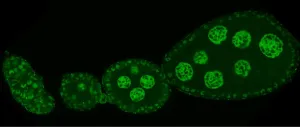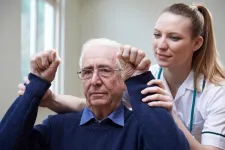Silencing by crosstalk
2021-02-16
(Press-News.org) Why do genes need to be silenced? The "genes" in question are in fact transposons, selfish genetic elements that seek to self-multiply at the host's expense and that need to be controlled. Julius Brennecke's group at IMBA focuses on lifting the mysteries of a specific type of transposon silencing, namely the piRNA pathway in animal gonads. Understanding this ancient silencing system promises to reveal general mechanistic principles of gene expression and chromatin biology.
Gene silencing: either before they "speak", or right as they attempt to
Heterochromatin, a tightly packed form of DNA, plays an essential role in transposon silencing and in safeguarding eukaryotes' genomic integrity. Distinct strategies are set in motion to guarantee that heterochromatin formation be sequence specific against undesirable genetic elements, or target loci. One such strategy uses so called nuclear Argonaute proteins, which are complexed with small RNAs that guide them to nascent transposon transcripts in chromatin (i.e., transposon mRNAs still associated with the transcribing polymerase). This strategy is therefore dependent on target locus transcription and is referred to as "co-transcriptional gene silencing". One specific Argonaute protein associated with co-transcriptional gene silencing in Drosophila ovaries is Piwi, bound to short piRNAs that are encoded by genomic master loci called piRNA clusters. Piwi-mediated silencing requires heterochromatin factors (silencing effectors) to be recruited, a step that is mediated by the SFiNX complex (silencing factor interacting nuclear export variant), a complex formed of the heterodimeric nuclear RNA export variant Nxf2-Nxt1 and the Piwi-associated orphan protein Panoramix (Panx). The SFiNX complex had been previously identified by four groups in the field independently, including the Brennecke lab. For more on this topic, have a look at a previous press release on how flies repeatedly coopted nuclear export factors for genome defense: https://www.imba.oeaw.ac.at/research-highlights/upcycling-of-proteins-protects-dna-from-parasites/ .
Cut up and the two SFiNXes
The current publication in the journal Genes & Development was spearheaded by the PhD student Jakob Schnabl and unravels the molecular mechanism and function of the SFiNX complex. The researchers first identified Cut up (Ctp), the Drosophila ortholog of the highly conserved Dynein Light Chain 8 (LC8), to be a functional member of the SFiNX complex. Intriguingly, Cut up mediates SFiNX dimerization, which turns out to be essential for its molecular functionality. "In order for Piwi to be able to silence transposons, the SFiNX complex needs to be dimerized by Cut up," says IMBA group leader Julius Brennecke. Just as one hand alone does not clap, it takes two SFiNXes, brought together by Cut up, to silence!
The least expected player and a myriad of other functions yet to be dissected
Jakob Schnabl has already been involved in the 2019 publication from the Brennecke lab describing SFiNX. This earlier work was guided by PhD student Julia Batki, who received award recognitions for her thesis and who is also an author on the current SFiNX publication. When asked about Julia's contribution to the Cut up paper, Jakob's eyes light up: "Quite some part of the paper is about this small protein [Ctp/LC8, aka Cut up] that acts as a dimerization mediator for the SFiNX complex, and there I collaborated very closely with Julia". Jakob elaborates: "Honestly, we originally thought that the Dynein Light Chain [Cut up] is a contaminant in our experiments because if you look at it superficially it just doesn't make sense that a component of a cytoplasmic motor protein complex is involved in nuclear SFiNX biology. But Cut up kept coming up in our interaction screens. At some point we just had to test for it directly with the aim of ruling out a function. That experiment, however, strongly pointed to Cut up being a functional SFiNX subunit!". Jakob goes on to say "In fact, when you look more closely into the literature, you notice that this protein [Cut up] is implicated in many, many functions! It is sort of a dimerization hub protein, yet somewhat overlooked in general".
A DNA-RNA crosstalk leading to gene silencing
Finding that SFiNX is a dimer set the stage for Jakob to characterize SFiNX biochemically. Jakob could show that dimeric SFiNX is able to interact with either the DNA target locus or the nascent RNA. These two distinct interactions ultimately lead to the same goal, namely transposon silencing. The authors also showed that the SFiNX complex can form condensates in vitro in the presence of nucleic acids and used this property to assay for SFiNX's ability to form multivalent interactions. In light of the new findings, the authors propose a model to explain the SFiNX complex's function and molecular mechanism. This model of multivalent interactions would involve a SFiNX-mediated DNA-RNA crosstalk to enable other domains within SFiNX or co-recruited silencing effectors to establish heterochromatin. "In the end, a nascent transcript is a transient molecule on chromatin, and SFiNX multivalency and its ability to bind DNA and RNA seems to be a key activity to keep the nascent RNA on chromatin. This might well be a more general mechanism underlying co-transcriptional or RNA-mediated heterochromatin formation," concludes Julius Brennecke.
INFORMATION:
Original publication
Schnabl et al., "Molecular principles of Piwi-mediated co-transcriptional silencing through the dimeric SFiNX complex", Genes & Development, 2021, DOI: http://www.genesdev.org/cgi/doi/10.1101/gad.347989.120
About IMBA
IMBA - Institute of Molecular Biotechnology - is one of the leading biomedical research institutes in Europe focusing on cutting-edge stem cell technologies, functional genomics, and RNA biology. IMBA is located at the Vienna BioCenter, the vibrant cluster of universities, research institutes and biotech companies in Austria. IMBA is a subsidiary of the Austrian Academy of Sciences, the leading national sponsor of non-university academic research. The stem cell and organoid research at IMBA is being funded by the Austrian Federal Ministry of Science and the City of Vienna.
[Attachments] See images for this press release:

ELSE PRESS RELEASES FROM THIS DATE:
2021-02-16
Many steep valleys in the European Alps show the relicts of large rockslides, during which several hundreds of million cubic metres of rocks get instable, collapse and impact everything on their path. "For most of these, we still do not know how they are caused, because these rockslides occurred long before the start of written history in the region about 1000 years ago," says Patrick Oswald, PhD student at the Department of Geology of the University of Innsbruck and lead author of the study. "Curiously, many of these ancient rockslides occurred together in clusters, meaning they are found in small regions and have a rather comparable age". This enigmatic pattern has puzzled researchers over the last decades and fuelled some intense debates. Some experts ...
2021-02-16
"Thin films are solid state substances that can be only several atomic layers thick. Usually, their properties are considerably different from the properties of the original substances on the macroscale. The areas of their application keep expanding and include nanoelectronics, optoelectronics, spintronics, electro-, and photocatalysis, as well as such important fields of economics as space technologies and instrument building. Micromodule devices for space crafts and medical technologies are also promising areas in which thin films can be used," said Vyacheslav Fominski, a project supervisor representing MEPhI.
To reduce friction and solve many ...
2021-02-16
Cataracts are the most common eye ailment in humans. However, the exact processes leading to this condition are not fully understood. A team of researchers headed by the Technical University of Munich (TUM) has now discovered that the composition of the protein solution plays a decisive role. Their conclusions are contrary to prevailing opinion in the field.
The cells in the lens consist of a highly concentrated protein solution that is normally clear. "When the balance of the proteins in the lens is destroyed, they clump together and the lens becomes cloudy," says Prof. Johannes Buchner of the Chair of Biotechnology at TUM. This results in the condition known as cataracts.
The clouding can have different causes. Because the proteins in the lens are formed ...
2021-02-16
The 'sloshing' of a quantum fluid comprised of light and matter reveals superfluid properties.
An Australian-led team of physicists have successfully created sloshing quantum liquids in a 'bucket' formed by containment lasers.
"These quantum fluids are expected to be as wavy as the oceans, but catching clear pictures of the waves is an experimental challenge," says lead author Dr Eliezer Estrecho.
Led by the Australian National University (ANU), the team serendipitously observed the wavy motion of the quantum fluid in an optically-controlled bucket, gaining new insights of the intriguing superfluid properties of this peculiar, hybrid light-matter system.
Superfluidity ...
2021-02-16
The processes in living beings follow a finely orchestrated choreography down to the molecular level. Rhythmic processes are found everywhere in biology, for example, the 24-hour circadian cycle, a kind of "internal clock", plays an important role in regulating many processes in living cells, including metabolism and cell division mechanisms.
Scientists from Saarbrücken and Kaiserslautern have now taken a closer look at a similar cycle, the somewhat shorter ultradian cycle of baker's yeast. Under the leadership of Bruce Morgan, Professor of Biochemistry at ...
2021-02-16
Combining healthy lifestyle interventions reduces heart disease through beneficial effects on different lipoproteins and associated cholesterols, according to a study published February 9 in eLife.
Having a healthy lifestyle has long been associated with a lower risk of developing heart disease. The new study provides more detailed information on how healthy lifestyles improve cholesterol, and suggests that combining cholesterol-lowering medications and lifestyle interventions may yield the greatest benefits to heart health.
Cholesterol-lowering ...
2021-02-16
The fact that cells are motile and come into contact with each other is one of biology's fundamental principles. During embryonic development, cells must communicate with their neighbors in order to find their proper place in the differentiating organism. Wound healing is another process in which direct intercellular interactions are essential. In this context, motility enables cells to migrate to the location of the lesion and regenerate lost structures. Cancer cells also make use of this property to leave their site of origin in the primary tumor, which allows them to initiate the formation of metastatic tumors in other tissues.
"In recent years, biologists ...
2021-02-16
An international study has shown, for the first time, that the capacity of the human brain to recover and rewire itself peaks around two weeks after a stroke and diminishes over time.
The finding, published today in the Neurorehabilitation and Neural Repair journal, is the result of a study in London and Adelaide that followed the recovery of 60 stroke patients up to one year after their stroke.
Lead author Dr Brenton Hordacre, from the University of South Australia, says the multi-site study showed conclusive evidence that the brain only has a small window of opportunity to more easily repair itself after stroke.
"Earlier animal studies suggested ...
2021-02-16
Icebergs are melting faster than current models describe, according to a new study by mathematicians at the University of Sydney. The researchers have proposed a new model to more accurately represent the melt speed of icebergs into oceans.
Their results, published in Physical Review Fluids, have implications for oceanographers and climate scientists.
Lead author and PhD student Eric Hester said: "While icebergs are only one part of the global climate system, our improved model provides us with a dial that we can tune to better capture the reality of Earth's changing climate."
Current models, which are incorporated into the methodology used by the Intergovernmental Panel on Climate Change, ...
2021-02-16
Over the past years, global data traffic has experienced a boom, with over 12.5 billion connected devices all over the world. The current world-wide deployment of the 5G telecommunications standard is triggering the need for smaller devices with enhanced performances, such as higher speed, lower power consumption and reduced cost as well as easier manufacturability.
In search for the appropriate technology, photonic devices emerged as the leading technology for the evolution of such information and communication technologies, already surpassing ...
LAST 30 PRESS RELEASES:
[Press-News.org] Silencing by crosstalk




